Anytime I’ve been in the hospital, and especially following a surgery, I am usually given an anticoagulant to prevent blood clots since I’m not walking around as much as I normally am. Blood clots can easily form when you are laying in bed and not moving around. There are a lot of risks that come with being in the hospital, that’s why they really try and get you discharged as soon as they can.
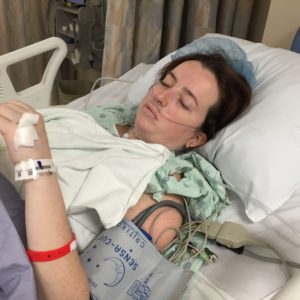
Well, last year during my endless hospital admissions I ended up with bilateral obstructing blood clots in my upper arms. However, I didn’t get them from being inactive and laying in bed. While I was in the hospital the doctors wanted me to get a PICC line to receive my TPN infusions because I have terrible veins and I needed a high volume of fluids, therefore it was vital that I needed a more central line than your typical standard peripheral IV.
Typically nurses that are specially trained come to your room to insert a PICC line. They use ultra sound and other techniques to place the line. It is a sterile procedure but does not take that long. In my opinion it hurts the same amount as a normal IV. Which is a simple prick. The nurse made several attempts, but could not advance the catheter far enough to where it needed to be. He left me with a mid-line (see below), which is almost like a PICC line, but the catheter doesn’t advance as far.
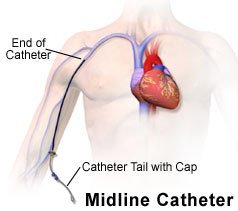
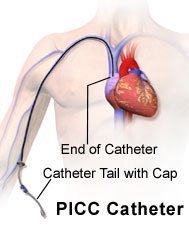
I was sent to the Interventional Radiology department of the hospital to have the PICC line inserted by a doctor under floroscope. I was assured this would work because they could clearly see my veins with the fluroscope and easily advance the catheter. I was almost twenty days into this admission (which was my second admission with an abscess) so I was already mentally and physically exhausted. The doctor and his team of techs made multiple attempts to advance the PICC line. Every time they made an attempt, they pricked my skin after injecting a local anesthetic to numb it. A local anesthetic stings and burns and I hate it and they insisted that it needed to be used EVERY TIME. I felt like a human ashtray that was being used to extinguish cigarettes.
They tried on both upper arms multiple times. I started to cry because I felt like a literal pin cushion on this table covered in sterile drapes with this team around me talking to each other about my veins and all their failed attempts. They had to give up and I was sent back to my room with a simple mid-line catheter, which is what I started the day with. The hassle would have been worth it if they were successful, so I was pissed and exhausted. No one brought up different IV access ideas, which looking back on, was pretty stupid.
Within a few days my right upper arm (where my mid-line IV was placed) was hurting and I couldn’t lift it. I mentioned it to my nurse and within a few hours I was sent downstairs for an ultra sound. They confirmed that I had an unobstructed blood clot. My mid-line catheter needed to be removed and replaced on my other arm, which was done later that day.
I was discharged within a few days of this and sent home with TPN infusions so my mid-line catheter came home with me. My first night I woke up and my arm where my newer mid-line catheter was inserted, was in severe pain (again). I knew what that meant. I had to stop my TPN infusion myself because it was too painful. I went to the ER that morning and at the same time my abscess came back (that’s another story) and they confirmed that I now had OBSTRUCTING blood clots in both upper arms!
They sent me back to see my friends in IR after I was readmitted. It was a different doctor and he explained that the order was to try again for a PICC line. I immediately stopped him and said no and told him what had happened. I explained that I didn’t want to keep doing the same thing and expecting a different outcome. He was great and I wish I could remember his name, because he understood what I was saying and respected my wishes, even though I don’t have a medical degree. He said lets try and put a tunnel catheter port in and he explained the process and it didn’t sound that bad. So that’s what we did and it was done in less than 30 minutes. They spent more time preparing and sterilizing the area than actually placing the line.

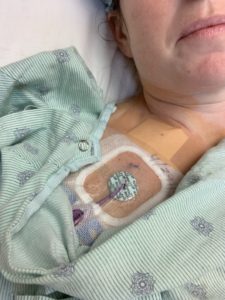
I can’t tell you how relieved I was when I had the port inserted and a viable IV access point that I knew was going to be fine. I was able to restart my TPN infusions and start getting the treatments I needed. I ended up going home with the port and having it removed 5 months later.
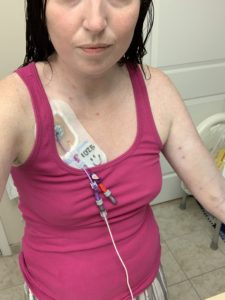
Now, for the blood clots. They were unable to use a blood pressure cuff on my upper arms because you don’t want to rub or squeeze the area that has a blood clot. They had to use my legs to measure my blood pressure even though the reading will be a little off. All of the nurses understood and had no issue, except for Nurse Ratched. She kept telling me that the reading would be inaccurate, and I told her I would rather have a blood pressure reading that was a little higher than have a blood clot travel and fucking kill me. Maybe I didn’t use those exact words, I’m probably para phrasing here.
They upped my dose of blood thinners and I was now getting two daily injections of an anti-coagulant. A hematologist was sent to see me and they said with the anti-coagulant treatment and time the blood clots would resolve, but they had to keep an eye on it and I was advised against rubbing or squeezing the area where the blood clots were. The soreness in my arms immediately started to show signs of improvement once the mid-line catheter was removed, it did take maybe up to a week later for it to feel 100% again. I was kept on the anti-coagulant as a preventative measure.
When I was discharged and finally sent home I followed up with my hematologist who has been treating me for anemia for the past ten years. He kept me on the anti-coagulant for as long as I had the port. Once the port was removed I was allowed to stop taking the anti-coagulant.
Now, I couldn’t have prevented these blood clots because they were a result of multiple botched PICC line attempts. However, it is very important to get up and walk around whenever you are in the hospital and stuck in bed. Walking helps get your circulation going and is a great way of preventing complications such as blood clots. Blood clots suck and trust me, you don’t want them. This ordeal was just a big nightmare within a nightmare and I’m so happy it’s behind me.